You have ridden western, but want to know will an Australian Stock Saddle suit you? Trevor James explains the difference.
The American Western saddle in its many forms all derive from the original concept of a saddle you can rope cattle with. Because of this they all have a horn for roping. The rigging dees on western saddles are for the most part, set at the front with a flank girth at the rear.
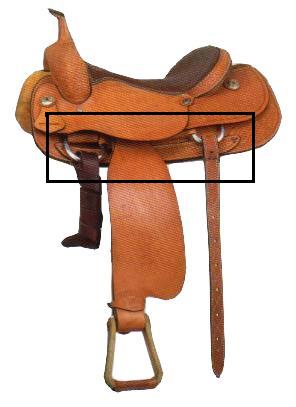
Above – The front rigging Dee is well forward under the swell. The rear flank girth is strongly attached and with this combination the saddle is very hard to pull off a horse and that is exactly what this saddle is ideal for.
This arrangement works very well for that type saddle. During roping enormous stress is placed on the saddle. When the steer hits the end of the rope the force exerted along the rope tends to pull the horse off its feet. When this doesnt happen the saddle takes the brunt of the force and the fact that the front and rear girth are set far apart prevents this from happening. If the saddle did not have a flank girth it would lift at the back and most likely, the saddle would pull off the horse. The position of the rigging dees and flank girth is great for the purpose it was designed for and that is roping.
An Australian stock saddle generally speaking does not have a horn. It does have a flank girth facility, but if you are not going to rope out of a saddle you really dont need a flank girth.
The position of the rigging dees on a Western saddle tend to place the saddle further down the horses back when compared to the position an Australian stock saddle takes on a horses back.
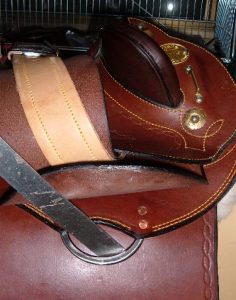
The rigging dees on an Australian stock saddle are situated a little forward of centre. This means that when girthed up the saddle is in a more forward position and the rider weight is more over the horses shoulders.
This is a huge plus for your horse. Instead of the rider weight being primarily being exerted on the back bone and associated skeletal frame, it is on the much stronger shoulder section. Take note the next time you are at the race track. The saddle on a race horse is made in such a way as to be up on the horses shoulder. When the horse is in full gallop and heading for the finish line, the jockeys stand in the stirrups and lean forward along the horses neck. They know that by taking their weight off the horses back, the horse can use its full strength and athletic ability to propell itself forward rather than supporting the rider weight.
The same principle applies to the position of an Australian stock saddle. Firstly its vastly more comfortable for your horse and less likely to exert pressure on the weaker backbone area of a valuable horse.
Secondly, if you are seeking an advantage in horse sports, then just like the jockeys in the horse race, you will find that using the light weight Australian stock saddle will not only be better for your horse long term, but it will give you and your horse a real edge in any competitive horse sport. It is light weight, strong and perfectly balanced.
Will the fender on an Australian Stock saddle feel and work the same as on a Western Saddle?
Australian Stock Saddles have traditionally had a stirrup leather 1 1/4″ wide. It has been mounted on a steel hook bar, which is a huge safety factor. If the rider falls and is being dragged, there is a good chance the stirrup leather would pull off the stirrup bar, thus releasing the rider being dragged. The narrow 1 1/4″ leathers were very flexible and allowed the rider great freedom of movement. The downside is that the leathers sometimes pinched and the buckles could rub on the inner leg. A wider 2″ leather became popular and did solve some of these problems. They were also stronger. It became apparent that the wider the leather, the more comfort and security was provided for the rider and the American style fender was introduced to the Australian Stock Saddle design. This proved to be a huge success. The fender when mounted on the stirrup bar still comes off if the rider falls and with the protection provided by the extra width of the fender you can virtually ride in shorts if you want to. The downside of the fender was that its width and wider 2 1/2″ straps made it very stiff and it would not move freely like the old style stirrup leather. Trevor James recognised this problem and designed a stirrup bar which is mounted on a steel roller bearing. The result is that the fender can now move freely to suit any rider style or unexpected situation. With this adaptation the fender is strong, provides rider protection and is absolutely friction free. It has been so successful that orders received by Trevor James these days are for fender saddles with the rotating stirrup bar. For more information on the rotating stirrup bar, click here.

Above – A traditional inch and a quarter stirrup leathers.
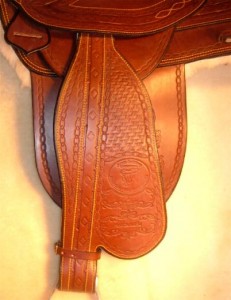
Above – American fender adapted to Australian Stock saddles.
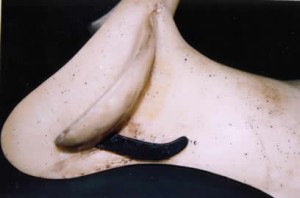
Above – Fender slies onto this stirrup hook so it may pull off if you are being dragged. 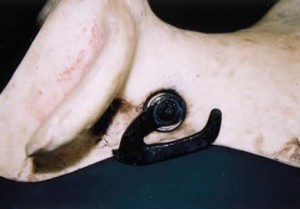
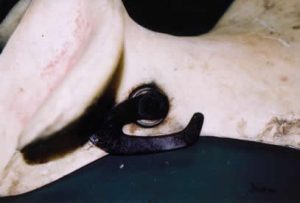
Above – Rotating stirrup bar allows full friction gree movement and perfect balance. 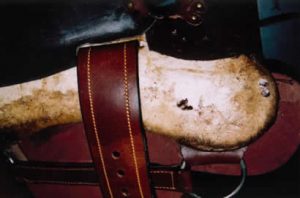
Above – Western saddles have the fender strap over the side rail, which is very restrictive. It cannot come off the tree if you are being dragged and can create a lump on the horses back.
Will an Australian Saddle feel or fit like an American Western Saddle?
The answer is no. The westtern saddle, because of its roping origin, is designed to sit low. The lower a saddle sits, the more closely it must follow the shape of a horses back. This means while it is low, it is also flat and wide. To be able to use the horn for roping, the swell and the horn are set at a forward angle away from the rider. This is necessary to allow the rider to wrap the rope around the horn while roping a steer.
In contrast, the Australian stock saddle maker takes great pride in achieving a narrow grip when designing and making his saddles. Along with the narrow grip the swell and horn of a western saddle is replaced by the kneepads. These knee pads follow the riders leg shape and contour. Should an unexpected problem arise, the rider slides in under the kneepads. The kneepads provide enormous security to the rider. When a rider is seated comfortably in the saddle with the fenders correctly adjusted, the rider should be able to slip a hand between their leg and the back of the kneepads. A side view of the rider should allow the saddle shape following the exact contours of his natural riding position.

The comparison shows the American western saddle is the best roping saddle. If you are not roping, but want a light weight, balanced saddle that distributes the rider weight to minimise damage to your horse and at the same time giving the rider maximum comfort and the best security for the rider, the Australian Stock Saddle is for you.

